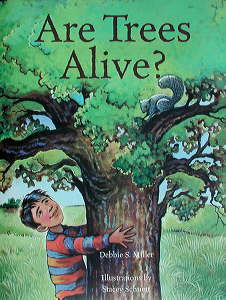
Trees are not animals, but are they alive? In Are Trees Alive? Debbie S. Miller compares the qualities and needs of trees to the qualities and needs of people. Even though trees are not animals, they are still alive and are extremely important to the world in which we all live.
Miller effectively explains the concepts of roots, trunks, habitats, bark, branches and leaves, pollen, seeds, dormancy, and the life cycle.
Bark is dark or light, rough or smooth, thick or thin, just like people’s skin. Bark Protects the inside of a tree from harsh weather and insects, like your skin protects you.
One of the most captivating features of the book is its multicultural theme; each concept is illustrated with a tree from a different part of the world. Stacey Schuett’s illustrations show people, plants, and animals from many cultures as the story teaches about the concepts and ideas, which are true of every tree and culture across the world.
Curriculum Connections
This book could be used in the lower elementary school grades to teach about life science and how trees and other plants are living things that have needs. In Virginia, Are Trees Alive? can be used in connection with SOL 1.4 in which students learn the life needs of plants (food, air, water, light, and a place to grow) and their functional parts (seeds, roots, stems, leaves, blossoms, fruits), as well as the classification of plants according to certain characteristics.
Additional Resources
- Instructions for paper tree crafts
- A form for tree similes
- Lesson Plan about the variation of leaves
Book: Are Trees Alive?
Author: Debbie S. Miller
Illustrator: Stacey Schuett
Publisher: Walker Publishing Company, Inc.
Publication Date: 2002
Pages: 26 pages
Grades: K-3
ISBN: 0-8027-8801-7
